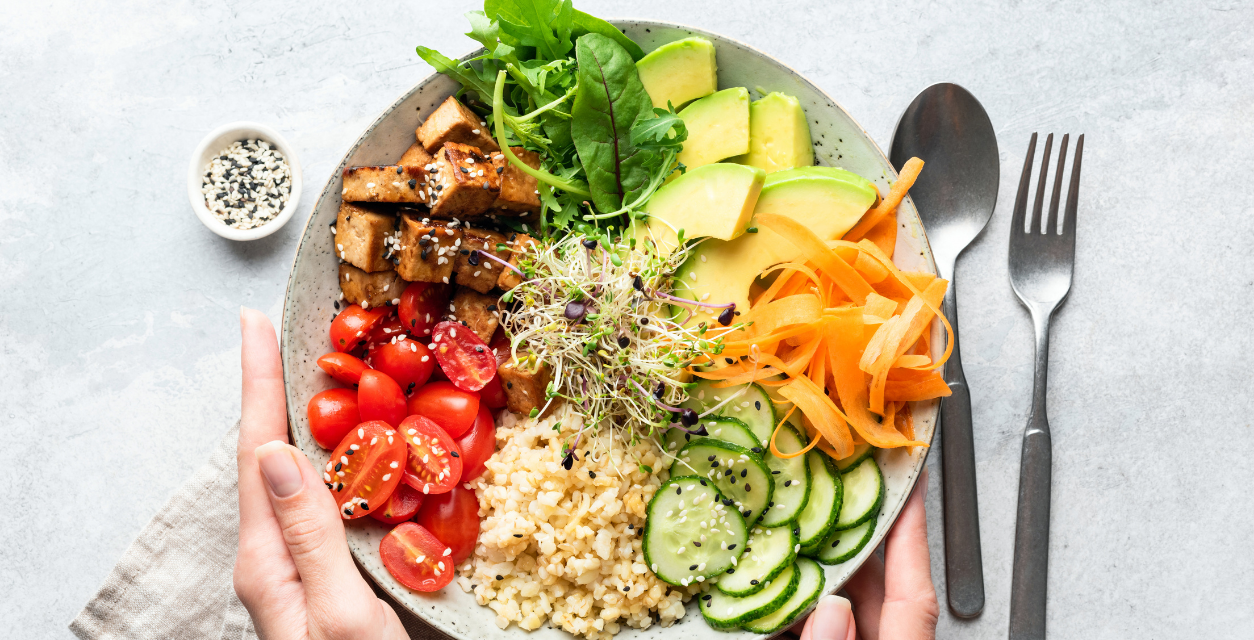When it comes to nutrition, balance can mean many things. Let’s start with the main components of your plate.
Eating healthy is actually pretty simple if you use the “plate method” recommended by USDA and the American Diabetes association. Basically, it’s imagining your plate in compartments—with ¼ of the plate having each of the 4 main food groups of Grain or Starch, vegetable, fruit and protein food with dairy on the side. With my clients, who are trying to lose weight, or prevent pre-diabetes or diabetes, I go one step further. Fill half your plate with non-starchy veggies like broccoli, carrots, spinach, green beans, kale, salad, etc. Eating half a plate of veggies ticks several boxes on a dietitian’s eating to-do list. First, it helps you get a variety of vitamins and minerals, but more importantly, it fills you up without a lot of calories. Win/Win!
But wait, there’s more! The filling fiber in those veggies are super powerful in your body—it slows down digestion, making you feel full longer, but also helps to moderate the rise in blood glucose that happens after a meal. The fiber in veggies is mostly soluble fiber, which is an enemy to high cholesterol—the same fiber that’s in oats and beans. (Beans are truly super foods, falling into both the carb and protein category!) Eating your veggies and fruits (which you should also eat 2-3 daily) also keeps digestion flowing smoothly. The phytochemicals found in veggies and fruits have been shown to lower your risk of cancer too, another plus!
Let’s talk protein. For people over 50, it’s recommended that you eat protein at each meal to prevent muscle loss, that unfortunately is part of aging. But you may have noticed there’s not a section on your portion plate for fat—and that’s because it’s often in or on your food. If you choose your protein wisely, you can keep saturated fat to a minimum and eat healthy fats in their place. Choose lean protein like fish (a few times a week), beans and legumes, chicken, lean pork and lean beef. Eggs are also a good quality protein. Limit processed meat like sausage and bacon, and skip the fried chicken, fried fish, etc.
Healthy fats are in the news a lot these days and with good reason. They add balance to your meal as they help you feel full. But the type of fat you eat can make a big difference to your health. Get most of your fat in the form of vegetable fat like olive or avocado oil, avocado, nuts and olives.
I haven’t forgotten dairy in this balanced meal. Most women and teens don’t get enough calcium in their diet and getting all your calcium from pills is controversial. You need at least three calcium-rich foods in your diet daily, which can come from dairy or calcium fortified foods.
So, what about diets that don’t include all the food groups? Hmmm. I’m talking about the super low-carb diets that cut out a few major food groups. Though they work for some people and definitely help with weight loss, they are mostly unsustainable. And in my professional opinion, the key foods that are missing are really essential for health. On the other hand, cutting back on carbs and only eating whole foods like veggies and fruit with some whole grains also work to win your health goals while still keeping the balance in your diet.












